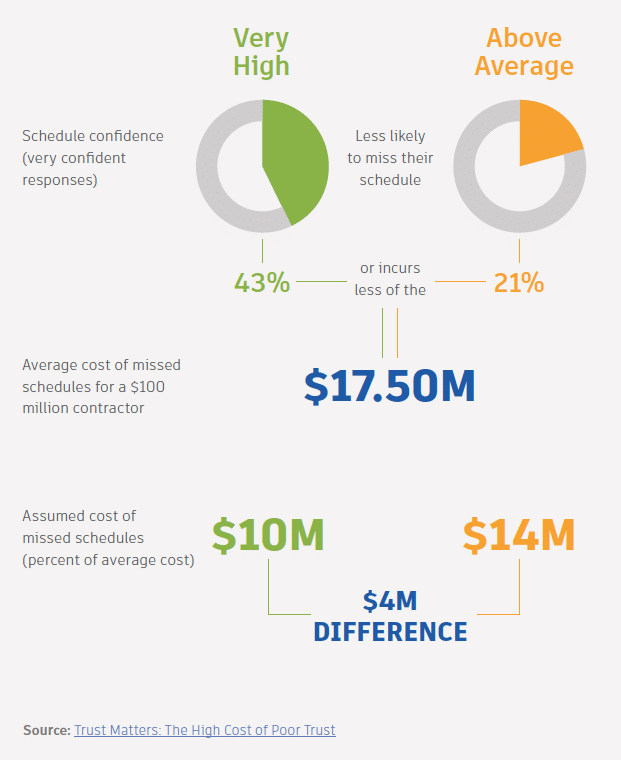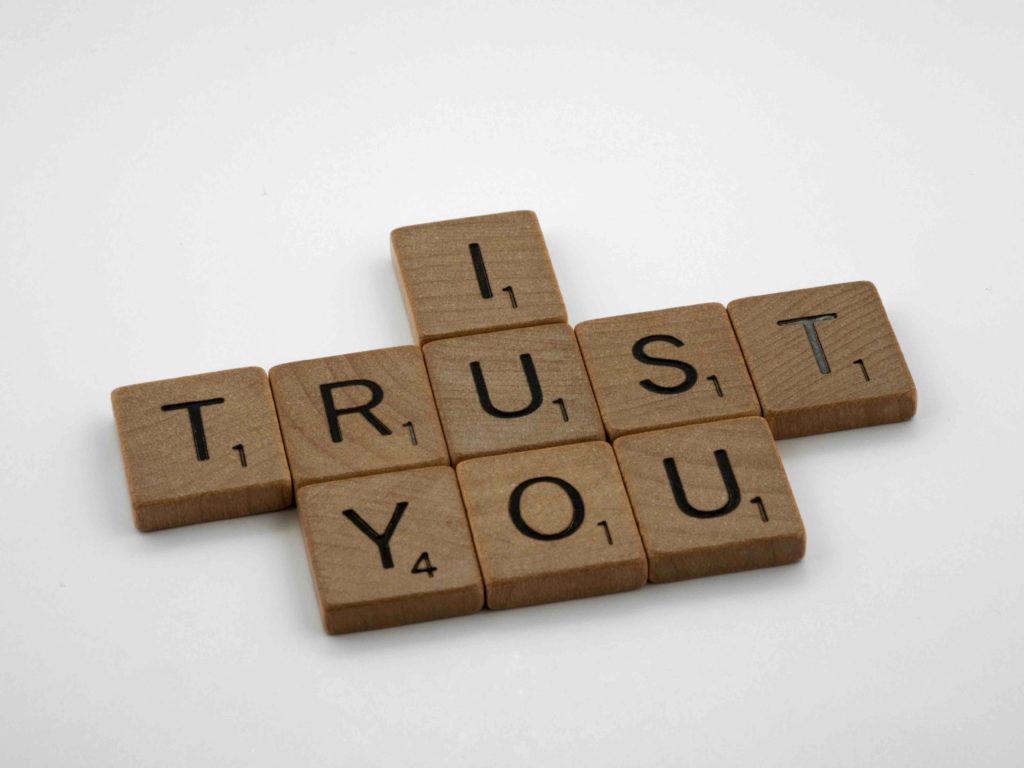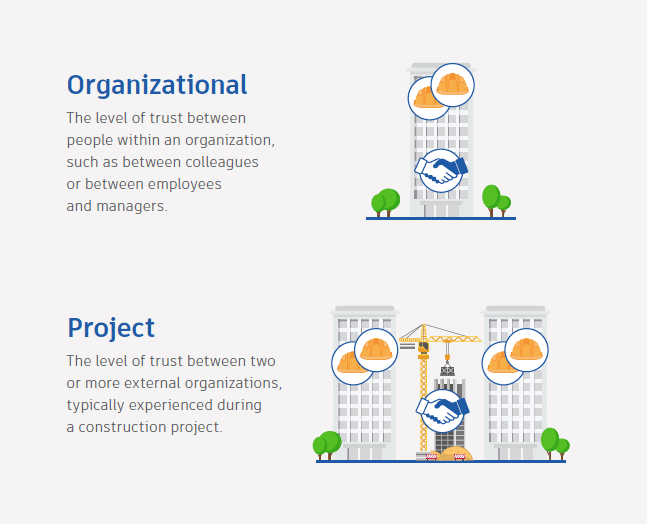This 3-part series based on my ebook Breaking Down the Breakdown: Trust in Construction explores the importance of trust in the building industry, analyzes the root causes of trust breakdown and offers strategies to build trust in construction teams.
We all know that trust is an integral part of any relationship, private or professional. The Merriam-Webster dictionary defines trust as “reliance on the character, ability, strength, or truth of someone or something.”
Looking at the construction industry, trust is also the foundation for digital transformation, which I will discuss in another article.
Internal vs external trust
In the construction industry, we have to deal with two interrelated forms of trust:
- Internal or organizational
- External or project-related
Illustration: FMI, ”Trust Matters: The High Cost of Low Trust.”
Key components of internal trust
If you look at high-performing organizations, you will find that they value transparency, autonomy, and clear communication protocols. These virtues begin (and end) with trust.
So what are the key components of internal trust?
- Transparency
Transparency leads to trust. This is true for any relationship. And the more so for team members in the construction industry. However, an area where transparency often fails is conflict. Speaking up when one has a different opinion on a critical next step in the project or feels that his/her career is possibly being impacted, requires a lot of courage. On the other hand, conflict for the sake of being right or not saying anything at all doesn’t help to build trust either. Only when we embrace different opinions and ideas, only when we have the ability to discuss what works and what doesn’t, can we explore opportunities and move closer to our common goal. What team leaders need to demonstrate is empathy, vulnerability, and emotional intelligence.
- Purpose-driven
Only when companies know where they want to go, when they have clear goals and intentions, in other words when they are purpose-driven, trust will flourish. Trust begins with shared empathy, but will stall when there is no shared intention to propel it forward. To improve internal trust, it is required to reflect on the mission, vision, and purpose of your company.
- Culture is the core
A company’s culture defines its shared beliefs and values. To create a culture where trust leads to higher performance, the culture must be driven by transparency and autonomy. Employees or team members are seen as empowered stakeholders who are encouraged to speak up and communicate any challenges when they arise. This autonomy results in improved workflow, more trust, and a culture of mutual respect and accountability.
External trust
External trust comes into play when organizations combine forces in high-performing project delivery teams. The higher the level of trust between the team members, the higher the profit of the project will be. External trust translates into increased profit.
In fact, according to the Autodesk & FMI’s report on Trust, organizations where trust is rated as “very high” can save as much as $4 million a year by just meeting deadlines.

External trust deals with the same factors as internal trust. Transparency, autonomy, and clear, consistent communication drive increased trust between owners, architects, engineers, general contractors, vendors, and every other stakeholder involved in a project.
If an organization has a culture where trust between employees and management is low or missing altogether, it is nearly impossible to establish trust between two or more external organizations - something we encounter on virtually every construction project. So one would think that trust is something that all construction teams are striving for.
Unfortunately, construction is no stranger to having issues with trust. According to John D. Macomber, Senior Lecturer at Harvard Business School “The entire construction supply chain works on contracts where the incentive is to maximize their gain at the expense of others.”
As a result, team members have no incentive to share mistakes in the spirit of the greater good. As vulnerability and trust go hand in hand, trust remains elusive in many traditional construction teams.
The exceptions are the teams who explore and embrace LeanIPD, a framework that challenges the traditional incentive structure by fostering connection and trust between all team members to empower them to optimize the outcome for all involved parties including the project owner.
The dance between relationships and results
Balancing client relationships versus business results becomes a key component to increasing collaboration. To achieve this, trust needs to be built through transparency, and the culture needs to drive innovation by embracing conflict in pursuit of a higher standard.
In the next article of this series, I’ll dig into a key step in the continuous improvement process that is often overlooked - the root cause analysis of trust breakdowns.
Further reading
Nathan Wood, Founder and Chief Enabling Officer of SpectrumAEC, is an innovation thought leader across the Architecture, Engineering, and Construction (AEC) industry. Nathan’s experience with Virtual Design and Construction (VDC), Lean process improvement, and Integrated Project Delivery (IPD) has led him to realize how proven technology solutions can too often result in adoption failure and lost ROI. Nathan blends Emotional Intelligence (EQ) with Design Thinking strategy to help teams overcome adoption barriers through collaborative debate and mutual respect for different perspectives.
Outside of SpectrumAEC, Nathan continues to support industry progress through speaking engagements, industry research publications, and as President of the Construction Progress Coalition.





